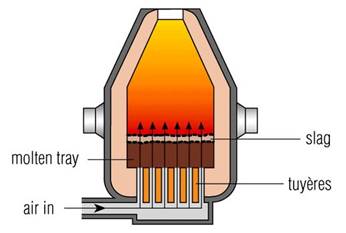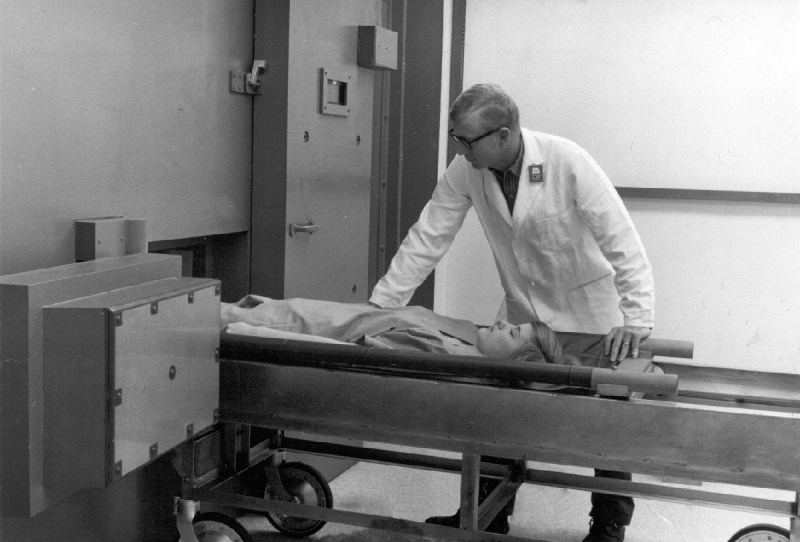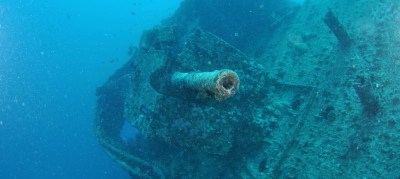The nuclear age changed steel, and for decades we had to pay the price for it. The first tests of the atomic bomb were a milestone in many ways, and have left a mark in history and in the surface of the Earth. The level of background radiation in the air increased, and this had an effect on the production of steel, so that steel produced since 1945 has had elevated levels of radioactivity. This can be a problem for sensitive instruments, so there was a demand for steel called low background steel, which was made before the trinity tests.

The production of steel is done with the Bessemer process, which takes the molten pig iron and blasts air through it. By pumping air through the steel, the oxygen reacts with impurities and oxidizes, and the impurities are drawn out either as gas or slag, which is then skimmed off. The problem is that the atmospheric air has radioactive impurities of its own, which are deposited into the steel, yielding a slightly radioactive material. Since the late 1960s steel production uses a slightly modified technique called the BOS, or Basic Oxygen Steelmaking, in which pure oxygen is pumped through the iron. This is better, but radioactive material can still slip through. In particular, we’re interested in cobalt, which dissolves very easily in steel, so it isn’t as affected by the Bessemer or BOS methods. Sometimes cobalt is intentionally added to steel, though not the radioactive isotope, and only for very specialized purposes.
Recycling is another reason that modern steel stays radioactive. We’ve been great about recycling steel, but the downside is that some of those impurities stick around.
Why Do We Need Low Background Steel?
Imagine you have a sensor that needs to be extremely sensitive to low levels of radiation. This could be Geiger counters, medical devices, or vehicles destined for space exploration. If they have a container that is slightly radioactive it creates an unacceptable noise floor. That’s where Low Background Steel comes in.

So where do you get steel, which is a man-made material, that was made before 1945? Primarily from the ocean, in sunken ships from WWII. They weren’t exposed to the atomic age air when they were made, and haven’t been recycled and mixed with newer radioactive steel. We literally cut the ships apart underwater, scrape off the barnacles, and reuse the steel.
 Fortunately, this is a problem that’s going away on its own, so the headline is really only appropriate as a great reference to a popular movie. After 1975, testing moved underground, reducing, but not eliminating, the amount of radiation pumped into the air. Since various treaties ending the testing of nuclear weapons, and thanks to the short half-life of some of the radioactive isotopes, the background radiation in the air has been decreasing. Cobalt-60 has a half-life of 5.26 years, which means that steel is getting less and less radioactive on its own (Cobalt-60 from 1945 would now be at .008% of original levels). The newer BOS technique exposes the steel to fewer impurities from the air, too. Eventually the need for special low background steel will be just a memory.
Fortunately, this is a problem that’s going away on its own, so the headline is really only appropriate as a great reference to a popular movie. After 1975, testing moved underground, reducing, but not eliminating, the amount of radiation pumped into the air. Since various treaties ending the testing of nuclear weapons, and thanks to the short half-life of some of the radioactive isotopes, the background radiation in the air has been decreasing. Cobalt-60 has a half-life of 5.26 years, which means that steel is getting less and less radioactive on its own (Cobalt-60 from 1945 would now be at .008% of original levels). The newer BOS technique exposes the steel to fewer impurities from the air, too. Eventually the need for special low background steel will be just a memory.
Oddly enough, steel isn’t the only thing that we’ve dragged from the bottom of the ocean. Ancient Roman lead has also had a part in modern sensing.
















Interesting, although I’d like to hear what underwater archeologists think?
They’ll be thinking “Sure are a lot of extremely generous grants around for locating and characterizing shallow water wrecks right now. Life is good. Maybe I’ll put that deposit down on that BMW.”
Except “extremely generous grants” do not exist in archeology. All the money is going to climate change scientists :)
it is so far from a one or the other scenario that the above comment is so far beyond wrong it aint even funny, especially when looking at the world and not a single, insignificant country.
No really?
The black humor there is that yes it’s normally such a poverty stricken field that a sudden commercial interest might warp scruples.
The globe is warming, the climate is getting disrupted, we are polluting the atmosphere with Carbon, and the climate is changing because of it. Do you even science bro?
After reading this article does occur to anyone that the post war atmospheric increase in radiation is a likely cause of warming rather than co2
WWII is archeology now? I’m really getting old.
Anything in the US over 50 years old is considered historically significant for construction purposes.
I, therefore, am historically significant.
… for construction purposes. Whatcha building?
One of the first things archeology students learn is that archeology is a destructive science. They will dig until they reach “geography” and then everything that once was there will be gone and transfered to paper.
Does anyone know who specialists in buying pre-nuclear metals ?
Radioactive elements get into steel from the coal that is used for the coke that is used to reducing iron oxide ores into pure iron. The coal deposits are full of uranium and thorium, along with their daughter isotopes which are concentrated in the resulting coal ash.
That includes also the so-called man-made isotopes such as Cobalt-60. It is generally said that these isotopes don’t exist in nature, but they are generated in trace quantities due to the breakdown chains of uranium and thorium, so some amount is always present in rocks and soil.
Iron oxide(s) are mined so blast furnace steel would not have the radioactivity problems of recycled steel. Why spend money dredging up old sunken armour when abundant iron oxides make up almost 10% of the earths crust.
because the process of making iron oxide into steel is the part that is making it radioactive.
That makes sense but I remember hearing pretty much this same story more than 10 years ago. Either someone is keeping a scam going a very long time or the naturally present radioactive isotopes just aren’t significant enough to cause a problem while the unnatural ones are.
As for the coal deposits… I would imagine not all coal deposits are equal right? Maybe they purposefully choose especially pure coal for making medical grade steel? Does anybody know anything about this?
at some point the lead roofing on old churches and ballast from old wrecks were in high demand for BGA balls because the slight radioactivity of new lead could make bits flip in ICs
Low-background lead is needed for extremely sensitive underground physics experiments. For the really, really low-background stuff (double beta decay, dark matter searches, etc) they want lead from relatively deep wrecks, which they move quickly to the underground sites in order to prevent activation from cosmic rays. Heck, they even store the detector materials themselves down-hole to let the activation products decay.
Why not use air filters? they absolutely could create low background steel today, they just find it cheaper to hire divers than it is to actually update modern foundries from the 1920’s tech to modern day tech.
Because most of the radioactivity in steel isn’t from the air?
I wonder if the high cobalt drills I use have a higher than background radiation level…any thoughts?
Sounds like you’ve found a great reason to build a Geiger counter as a future project :-D
I have been looking for an excuse…
Probably. When I worked at the Defense Nuclear Weapons School, we were surveying our radioactive training sites. I walked off site out of curiosity and found a natural rock that exceeded the NRC limit of 2 mRem / hr. This was near Albuquerque. I still have the rock. When I assayed it, it showed Uranium ore. Our training sites were seeded with natural Thorium.
Not mine! I cut all my drill bits myself from bits of the Titanic!
Underwater ships from WWII are also the graves of the sailors that lost their lives when the ship was sank.
Demand for this low emissivity steel is causing underwater graves to be desecrated.
Very true.
So we should also abandon/not rebuild cities which were destroyed by earthquakes causing countless deaths, because this would be desecration?
or reuse graveyards, something that is extremely common throughout history.
I think I saw that movie. :-)
I don’t think the dead care. What about the ones who were turned into a red mist and greasy smoke? Or burned up at 20,000 feet? Or recycling the hulks of burned out tanks?
Nobody worries when they eat tuna.
Well the left over 16′ cannon barrels from the Iowa class as well as the unused shells could be a large source of steel.
Some ships were sunk with zero loss of life.
https://en.wikipedia.org/wiki/Scuttling_of_the_German_fleet_in_Scapa_Flow
I never really understood the grave desecration argument.
My rational side says a dead body is not a person. The person who it once was has no cares and doesn’t know what happens anyway. Decisions should always be made to favor the living.
My irrational side imagines being a shipwreck victim myself. The thought of being trapped miles underwater sounds scary. I would rather my body brought back up. Do what you will with the broken metal can you find it in. Of course… I am not a sailor. Maybe their love of the sea makes it the perfect place for them to stay.
People do like pretty cemeteries though. Shipwrecks don’t look like that. They look more like illegal side of the road garbage dump sites. If the bodies remain behind then maybe cleaning up the trash is a respectful thing to do.
It helps nobody, if it would not be done, and btw. probably the corpses are already decayed and rotten or even eaten by marine life.
Most of the Low Background steel in use has come from the armour of the German High Seas Fleet scuttled at the end of WW1. There were now bodies in these ships, and most of them were salvaged in the 1920s and 30s. It’s a fascinating story. Here are a couple of interesting links. Some of the techniques Cox developed are definitely hacks! I read a book about Ernest Cox and the Scapa Flow salvage back in the 70s when one of my hobbies was naval history.
http://www.scapaflowwrecks.com/history/salvage.php
The Man Who Bought A Navy: The Story of The World’s Greatest Salvage Achievement at Scapa Flow – https://en.wikipedia.org/wiki/Ernest_Cox
As this steel runs out the market has caused a new sort of piracy. Particularly around the sites naval battles in WW2, ships are being plundered without permission and in secrecy. Recent surveys have found ships either partially or completely removed from their known locations on the sea bed.
http://www.livescience.com/56965-wwii-shipwrecks-vanish-after-illegal-plundering.html
http://www.telegraph.co.uk/news/2016/11/16/dutch-probe-mystery-of-wartime-shipwrecks-that-appear-to-have-go/
PS I forgot to mention that the inter-war salvage had nothing to do with low background steel, but rather the very high quality of the Krupp armour. It was only after 1945 that the remaining stock-piles of this became even more valuable.
In the notes section of the book “E = mc2 A biography of the world’s most famous equation” (i highly recommend reading this book), the author David Bodainis mentions the salvaging effort of the german fleet in Scapa Flow. But the most interesting claim is, that parts of these ships made all the way to the moon as parts of the Apollo spacecrafts.
David Bodanis references the book “The Grand Scuttle: The Sinking of the German Fleet at Scapa Flow in 1919” as the source of this claim, but i couldn’t find a copy to verify it.
@Sadiq Mohamed
So we filled the atmosphere with so much atomic murderdust it impedes construction of unimaginably sensitive scientific instruments. This turns artifacts from the most destructive war in human history into a valuable commodity, to the point where people–not nationstates, not huge mega-corporations, but groups of regular folks–are stealing warships off the goddamn *seabed.*
This is the most postmodern things I’ve seen since my friend made $90 trading imaginary hats.
Nice post HaD (and yes – it’s not technically a “Hack”). While I know about this subject, it is good to see an interesting post about something many others may not know about. And here’s a link to a page on Wikipedia about this subject but seemingly not referenced in this post:
https://en.wikipedia.org/wiki/Low-background_steel
“so the headline is really only appropriate as a great reference to a popular movie.”
When I clicked on the link “popular movie” I was directed to zoolander (2001)… could somebody explain what this has to do with the article?!?!
It is the “blue-steel look” from the movie. It’s so hot right now.
Damn, are we going to have to teach the classics in school, “Early 21st Century Popular Culture and Memeology 101”
https://youtu.be/FAxJECJJG6w
Fairly sure there were some naval scenes in The Eagle Has Landed with Sutherland.
Just a minor point: the Bessemer Process is obsolete and hasn’t been used in the United States since 1968. Primary steel, made from raw materials, is now made in basic oxygen furnaces, which are similar in concept to the Bessemer Converter but use pure oxygen instead of air and allow better control of the steel chemistry. Electric arc furnaces are used to make secondary steel, steel made by mixing scrap metals to get the right chemistry. I don’t doubt the need for low-background steel, but I wonder if primary steel made in modern BOP furnaces absorbs as much radioactivity as Bessemer steel.
with proper control one could probably make steel today with a lower background than what existed before any nuclear research at all took place.
Hmm.. what a great question. I can’t imagine where one would find the answer. Where oh where would I look? I guess I could try reading the article.
” Since the late 1960s steel production uses a slightly modified technique called the BOS, or Basic Oxygen Steelmaking, in which pure oxygen is pumped through the iron. This is better, but radioactive material can still slip through.”
Great article, thanks for a good read!
https://en.wikipedia.org/wiki/Radiation_effects_from_the_Fukushima_Daiichi_nuclear_disaster#Distribution_outside_Japan
Between the Fukushima disaster and whatever is going to happen involving North Korea, I’m pessimistic about the current and future levels of background radiation. :/
On a related (and somewhat political) note, the whole “bring our troops back from Japan and let them have their own army with nukes” idea might have worked well BEFORE North Korea had nuclear weapons.
NK doesn’t have enough missiles, subs, or planes for the full nuclear triad. Even if they did they don’t have enough warheads for a full MAD second strike. Even if they did they don’t have enough land for all the silos it would take. They do not, in fact, have a credible nuclear deterrent.
As it is, they’re equipped to fuck up South Korea OR Japan, after which they would be completely flattened. They know that the moment they launch they would be on the receiving end of a multi-axis hatefuck that would make Grave of the Fireflies seem like Miracle on 34th Street.
Even under the leadership of an unstable psychopath with bad hair they’re not going to nuke anybody because that order would have to go through a significant number of people deeply invested in the status quo, at least a few of which are statistically likely to be sane. We are not talking about a country with an entrenched and fortified quick-launch system built up through decades of nuclear development and doctrine.
No way! NK looks like an awesome country, according to this South korean should be waiting in line to go there!
“As it is, they’re equipped to fuck up South Korea OR Japan, after which they would be completely flattened.”
Agreed but… If all that came to pass… how would China react?
How would reunification work?
Would the South Koreans actually choose to put themselves under Kim family rule?
Or would our favorite North Korean dictator just give up all his power voluntarily?
How does either one make any sense?
Low-alpha lead is hot now also.
World war 2 battleship armor makes for great shielding for low level counting. Yay shielding! This underground facility at the DoE’s Savannah River Site pretty much takes the cake:
http://srnl.doe.gov/facilities/facilities_ultra-low.htm
http://c-n-t-a.com/srs50_files/271boni.pdf
Electrochemically controlled iron isotope fractionation
http://sims.ess.ucla.edu/eyoung/reprints/Black_etal_2010a.pdf
Must be an expensive process if the following is still worth the trouble.
War heroes’ graves ‘LOOTED’ after British battleships from WW2 go missing from seabed
http://www.express.co.uk/news/world/733462/War-graves-disturbed-Indonesia-British-ships-Battle-Java-Sea-removed
I wonder who the end client is?
Though there would be some cost involved you could acquire oxygen for making new steel from electrolysis of water sources which are not contaminated(deep sea, glacial ice, natural aquifers).
Similar to Low-alpha / antiquity lead used by the semiconductor industry.
i have 130 tons of it, made in 1937, make an offer, cut up and on your truck
So how much? The last time I bought the Golden Gate it was just $500.
If you’re serious, you want to look up where the market for that is. Certainly some people are willing to pay a lot. I’d guess there are brokers who locate it, store it, and sell it to the few scientists who need it. Find yourself a specialty scrap metals broker?
The radioactivity has increased because, you know, nuclear weapon USE. Is incredible? Is not. In Serbia (Yugoslavia) NATO has used depleted uranium projectiles – just one example. Perhaps, is better to have a Geiger counter when you visit other countries, mostly present/past war zone. Ussualy paranoia don’t kill peoples.
Depleted uranium is not a nuclear weapon. There are no fission products. It’s a heavy metal that does not spread around much.
If the remains are radioactive is enough. Is not necessary to have an explosion. I bet you don’t want to live in those areas. Those projectile are just https://en.wikipedia.org/wiki/Dirty_bomb
Depleted uranium is less radioactive than natural uranium.
Yeah but natural uranium tends not to occur around where people live, in any great quantity. People naturally get very little exposure to it. Especially in powder form.
There is some evidence that even used Plutonium was used in some warheads. Rates of cancer in Serbia have doubled since NATO invasion in 1999. Even some occupying NATO troops were affected (Italians, etc.).
I dunno, I’ve seen people paranoid of insects nearly crash their car trying to swat one…
What an unexpectedly fascinating subject … awesome blog!
Radioactive steel in laptops (documented a case here) can cause problems with sensitive drives.
I’ve known of this for sometime; and WWII sunken ship/gravesights have been vanishing over the past few years/decades. I suppose they can’t beat the criminals so they are going to join them.
Thing is:
I just replaced all of the Iron pipe that was the heating system in my 1921 built house with pex and some copper. I’m keeping the radiators. I actually took my time and hardly damaged any of it and its mostly reusable as is. However i plan on scrapping most of it and its a significant amount; I’d rather not have it mixed with the non-desired post nuke steel and even though I am a very experienced “scrapper” I have no idea how to proceed or where to take it. Does anyone have any tips or guidance? Who buys this ‘clean Iron? Where are they located? And is it really worth it to travel further etc? (Not complaining, just curious now) (Come on BIG BUCKS!! (Hopefully?) Thanks in advance for any information.
Wow, my comment just vanished before I could complete and post it. Dag gone it! That toook me some time….
My question to anyone who may know is:
Where can a person take clean pre-Nuke Iron in order to scrap it and have it processed in a way that is helpful to ‘the system’?
Is it worth much more than the ‘dirty’ radioactive variety?